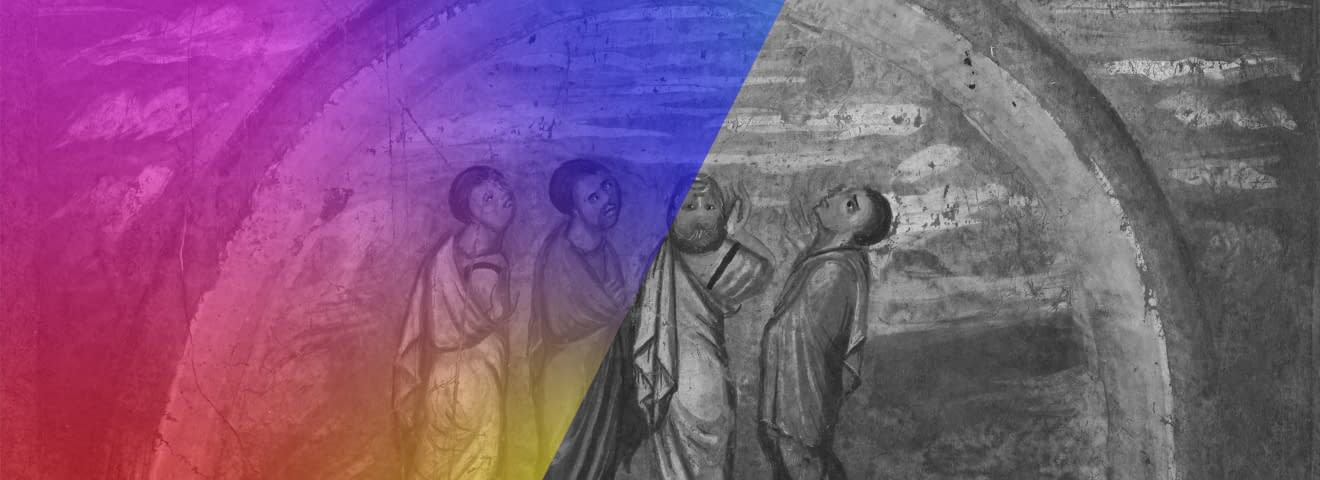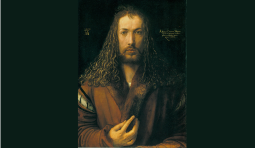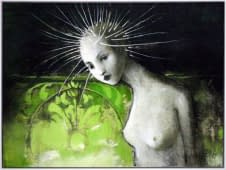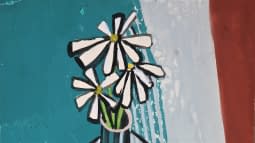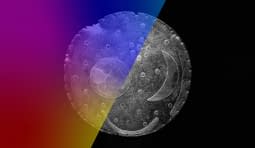The Rainbow #2 - Rainbows in Representations of the Middle Ages
From Prehistory and Early History to Christian Iconography
In the first blog we learned about the relationship between the natural phenomenon of the rainbow and humans in early cultures, religions and mythologies. The phenomenon was enriched with meanings, ideas and expectations and cultivated for the purpose of humankind. People always looked for something practical in nature, something that goes beyond mere existence, that is usable and useful ideologically, and that conveys something higher. This was because natural phenomena such as the rainbow were not yet explainable and thus the essence of nature, of the material world, was also a mystery to humans. In the second blog, we turn from a global perspective of prehistory and early history to a more European view. Namely, medieval rainbow depictions and the meanings they had in a society shaped by Christianity.
Control Through the Divine
Nature gave people security in their existence, for example by providing food. But at the same time nature could be brutal and destructive. Fear and gratitude are thus closely intertwined. By interpreting natural phenomena as something divine, these unpredictable discrepancies and opacities of nature made sense. These justifications gave rise to an ideal interpretation, which in the Judeo-Christian religion gave way to the «path of communication» (original quote: «Verständigungsweg», WKV, p. 24) between nature and man to an «extra-natural divine instance» (original quote: «aussernatürliche göttliche Instanz», WKV, p. 24). The ephemeral visibility and the semicircular form gave the rainbow something unifying. Due to its rare and sudden appearance in the sky, as well as its short duration, it continued to have a fascinating and intangible effect at the same time. For these reasons, it was a miracle for religious people. It was and still is impossible to find it, to enter it and to touch it, which is probably why the belief and the wish arose at the same time that whoever reached it would gain access to something wonderful, would be absorbed into heaven and transcend into another sphere. Charging nature's power with a divine meaning turned natural phenomena into symbols. Thus, the rainbow became a bearer of hope in Christian iconography, as a bridge between humans and God, towards a unity. As mentioned in the rainbow blog #1, there is an early literary event in the Book of Genesis, chapter 9, in which the rainbow is given an important role. Namely, the story of Noah and the Ark, borrowed from the Epic of Gilgamesh. So, was the rainbow a sign of a wishful thinking to reach the unknown supernatural and to come closer to God?
The Rainbow in the Book of Genesis
Noah and his family, as well as a pair of each of the other living creatures, survive the great Flood under the protection of the Ark, brought upon the world by God's Word. According to God's judgement, water was to pour down from the sky for 40 days and 40 nights. The word and its sign are closely linked. For at the end of the Flood, a rainbow appears in the sky as a sign of the covenant: With this sign, God promises never again to destroy all life on earth with a flood. Thus, in Christianity, the idea of peace was transferred to the rainbow. But why did God destroy humanity and everything that surrounded it? And why did Noah and his family enjoy his protection?
For God, the people he himself had created were corrupt. For they were violent and exploited each other, as they did the earth. God repented of his work of creation and concluded that humanity was evil. He punished them by destroying them again and starting all over. The animals, like Noah and his family, were to remain alive. For Noah was the only one who lived according to God's idea. After the Flood, they are to multiply again. After 150 days, the water level began to sink and the ark became stranded on Mount Ararat. After the dove finally returned with an olive branch as a sign that they could leave the ark, they made an offering to God in thanks. He then made the rainbow appear as a sign of the covenant between him and man. God spoke before the Flood: «[F]or the imagination of man’s heart is evil from his youth» (1. Moses, 8,21). This means that he now lets mankind do its thing because they can't be changed. The Flood is thus a harbinger of the eschatological end of the world, which is announced in the Revelation of John and found its way into the Bible of the Western Church. In it, a new world is announced. This world will be completely different, without evil, without heaven and earth. But until then, God is still delaying the end of humanity in order to show patience, that all have the chance to repent. This makes the Bible a book of hope that human beings can be good. This is symbolised by the rainbow.
The Iconography of the Rainbow
God spoke: «I have set my rainbow in the clouds, and it will be the sign of the covenant between me and the earth» (Gen. 9,13) A miniature in the «Viennese Genesis» (Cod. Theol. graec. 31), a Greek manuscript dating from the middle of the 6th century and possibly of Jewish origin, is considered to be the earliest depiction of this covenant. It shows Noah with his three sons Shem, Ham and Japhethi. Their heads are turned upwards towards the sky. For there appears a three-coloured half-circle rainbow encompassing the group. From the cloud in the centre of the arch, the hand of God pierces the arch, performing the gesture of blessing. They are receiving the covenant of God. Due to the iconoclasm, the survival of this illuminated manuscript is particularly remarkable.

An example of Byzantine-influenced art in the West is the Gospel Book of Otto III from Munich. Here, for example, the Evangelist Luke sits on a rainbow while his feet rest on another rainbow (998-1001 AD). This refers to the Old Testament, which forms a unity with the New Testament, and at the same time to the impending Apocalypse. In the Ark Noah depictions, a further element was added somewhat later. The moment when Noah, his family and all the animals leave the ark. This scene is depicted, for example, in a mosaic of the Cappella Palatina in Palermo (ca. 1160/70) or in the picture cycle of St Mark's Cathedral in Venice (12th century).
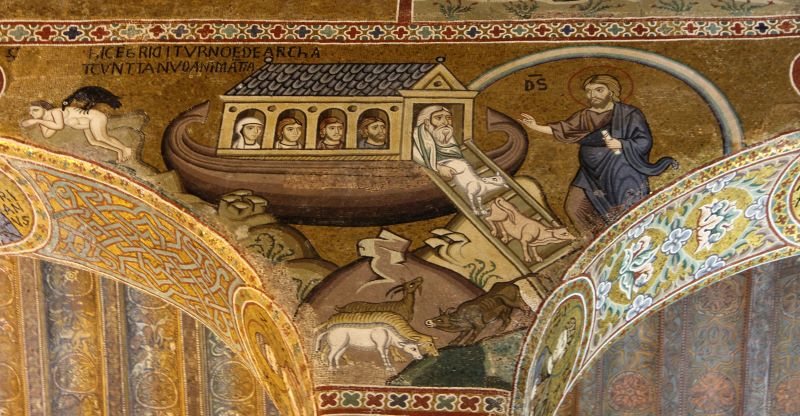
A little later, a new pictorial motif is found in the cathedral of Monreale. Noah, his sons, his wife and his sons' wives, who have left the ark and are offering a burnt sacrifice to God (ca. 1185/90). Here the rainbow connects the group and the altar of sacrifice.
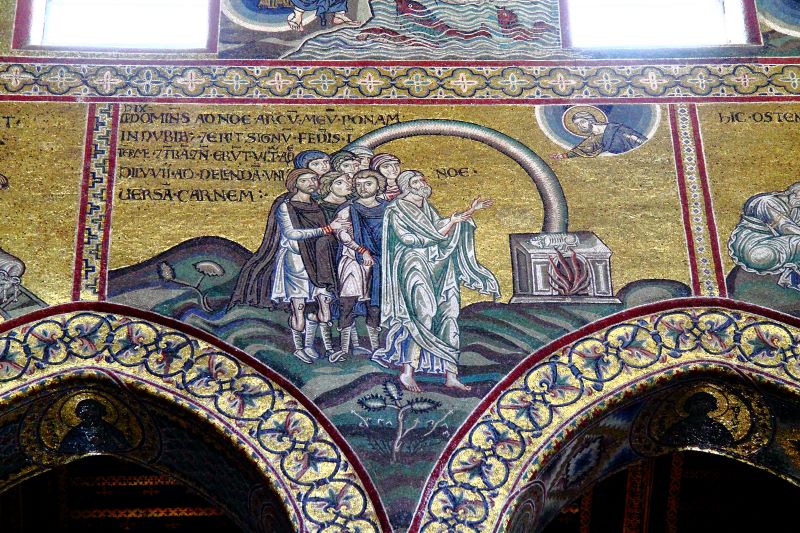
Much later, the rainbow was then omitted altogether, so that the representation of the divine covenant was now dominated by the scene of the thanksgiving sacrifice. This was the case, for example, in the ceiling fresco of Michelangelo's Sistine Chapel (1508-1512). However, the knowledge of the connection and the link between these events had not disappeared. For the rainbow would later find its way back into the world of painting. As a sign of salvation, however, it stood from then on for «God with us». The symbol and this meaning could therefore also be applied to a range of other themes. But you will learn more about this in the following blogs.
In addition to the depictions around Noah, the rainbow was also depicted in the Middle Ages in representations of the Last Judgement and its original motif of Christ in glory, the so-called Maiestas Domini. This motif of Christ seated on his arched throne is of Byzantine origin. One of the earliest representations of this kind is that of the former monastery church of Hosios David in Thessaloniki from the 5th century.
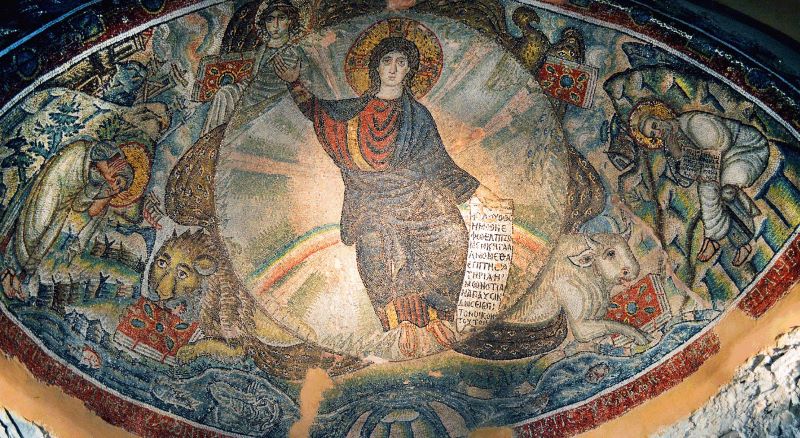
The Bible is also the source of imagery for this, for example Ezekiel's vision of God in the Old Testament and the Revelation of John. Here are two excerpts from the visions:
«As the appearance of the bow that is in the cloud in the day of rain, so was the appearance of the brightness round about. This was the appearance of the likeness of the glory of the Lord. And when I saw it, I fell upon my face, and I heard a voice of one that spake.» (Ezekiel, 1,28)
«And the one who sat there had the appearance of jasper and ruby. A rainbow that shone like an emerald encircled the throne.» (Revelation of John, 4,3)
The rainbow is seen here as a sign of the glory of God/Christ and thus corresponds to the meaning of the glory/mandorla itself, which often also appears multicoloured. Thus, there seems to be a connection between these elements. The colours, shape and texture of the rainbow reflect this glory and perfection of God, allowing the elements to also appear separately. Thus, the rainbow on which Christ is enthroned, for example, does not necessarily have to have iridescent colours or the «illusionary materiality of the real rainbow» (original: «illusionierte Materialität des wirklichen Regenbogens», WKV, p. 72). Moreover, these elements could also be transferred to other objects and beings, such as angel wings as «insignia of divine origin» (original: «Abzeichen göttlicher Herkunft», WKV, p. 72). In the «West», the motif was depicted from the 9th century onwards.
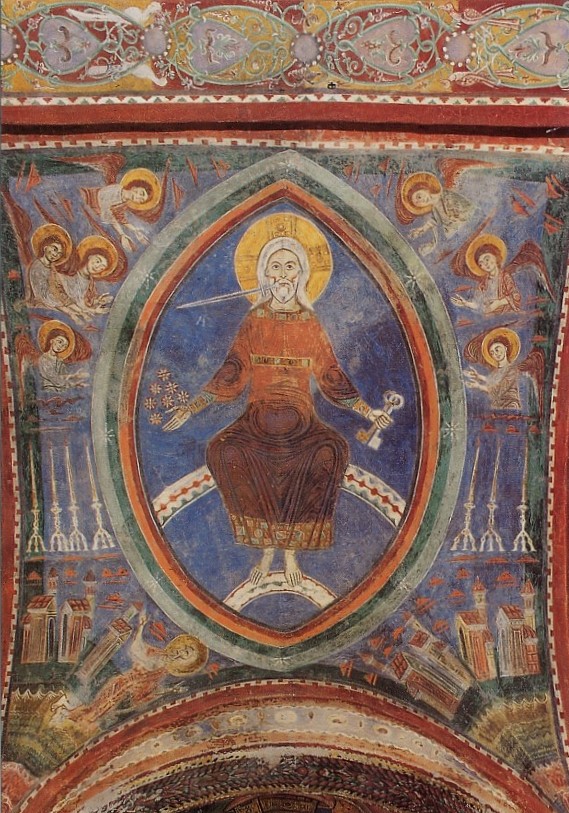
In the 13th and 14th centuries, the Maiestas Domini was replaced by the motif of the Judge of the World. The enthroned Christ on the rainbow in the mandorla was integrated into it as a central element. The Flood thus served as a pregifuration, a foreshadowing of the coming, final Last Judgement, which is usually depicted with the motif of Christ as Pantocrator, which is why the mandorla was later no longer absolutely necessary. At the Last Judgement, sinful people no longer encounter the destructive fury of water, but the fire of hell. Although the two representative, symbolic colours of the elements, the blue of water and the red of fire, are not opposite each other in the optically true rainbow, this was not taken into account in the literature of the time, but ignored the fact that the bottom is violet.
Representation of the Divine
The rainbow was not only a sign of the covenant but was also understood as a sign of the heavenly body of Jesus on earth (Nicole Omresme, ca. 1325-82). This points to what is incomprehensible to man in the divine. As a reflection of the divine light, it merely hints at the divine and appears accordingly in divine visions. Isidore of Seville (ca. 560-636) said that the semicircle of the rainbow is derived from the brightness of the round sun, the symbol of God. You will find out next month how these motifs developed in the late Middle Ages and the transition to the early modern period!
Glossary:
Iconography: A scientific method in art history by which motifs in works of art can be identified and interpreted.
Ephemeral: From the ancient Greek for «lasting only one day», meaning something that only lasts for a short time, something that passes fleetingly, quickly.
Prefiguration: In the biblical interpretative tradition, prefiguration (also typology) means the relation/reference of a person or story from the Old Testament (typos) with a person or story from the New Testament (antitypos). The preceding story thus indicates the following story and thus establishes a tradition that creates legitimacy and continuity through this historical reference.
Pantocrator: From the Greek and means «ruler of the world» or «ruler of all». From around the 4th century, the name has been used as a «synonym» for Jesus Christ. Before that, the term was used for God the Father. Correspondingly, in art history there is a typological representation of Christ as Pantocrator, where he is represented as an icon.
Photo Credit:
Figure 1: God's covenant with Noah, Cod. Theol. greek. 31 = the so-called Vienna Genesis, fol. 3r, 6th century AD, Austrian National Library, Vienna. Photo: ÖNB Digital.
Figure 2: Noah leaves the ark, mosaic cycle of images in the Cappella Palatini, Palermo, c. 1160/70. Photo: Codex, CC BY SA 4.0.
Figure 3: Noah and his family offering the burnt offering, mosaic, Monreale Cathedral, ca. 1185/90. Photo: Rabel, CC BY SA 4.0.
Figure 4: Photo: Maiestas Domini, mosaic in the former monastery church of Hosios David, Thessaloniki, 5th century. Photo: The Byzantine Legacy, CC BY SA 4.0.
Figure 5: Photo: Apocalyptic Maiestas, Crypt of St. Magnus, Anagani Cathedral, ca. 1255. Photo: Anonymous, https://www.gliscritti.it/arte_fede/anagni/apoc_anagn.htm, Wikicommons.
Cover Picture: God's covenant with Noah, Cod. Theol. greek. 31 = so-called Vienna Genesis, fol. 3r, 6th century AD, Austrian National Library, Vienna. Photo: ÖNB Digital.
